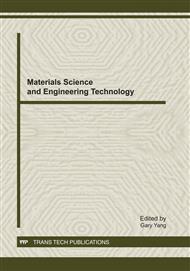p.52
p.57
p.61
p.65
p.69
p.73
p.78
p.84
p.89
Effects of Inorganic Anions on TiO2 Photocatalytic Reduction of BrO3
Abstract:
The effects of various inorganic anions (SO42−, NO3−, HCO3−/CO32−, Cl− and I−) on the photocatalytic reduction of BrO3- were investigated under UV light irradiation. The effects of the inorganic anions depend strongly on the property of radical scavenging and adsorption. At the concentration of 1.56 μmol/L, NO3−, SO42−, HCO3−/CO32−, Cl− and I− exhibit the property of radical scavenging and promote the reduction of bromate. At higher concentration than 1.56 μmol/L, NO3−, SO42−, and HCO3−/CO32− exhibit the property of adsorption and decrease the promotion of the reduction of bromate. Cl− has little effect on the reduction of bromate, it is due to the ability of the radical scavenging is lower than that of Br−. Only I− has a higher promotion of the reduction of bromate at higher concentration than 15. 64 μmol/L, it is due to the strongly reduction potential E0(•I/ I−).
Info:
Periodical:
Pages:
69-72
Citation:
Online since:
January 2012
Authors:
Keywords:
Price:
Сopyright:
© 2012 Trans Tech Publications Ltd. All Rights Reserved
Share:
Citation:


